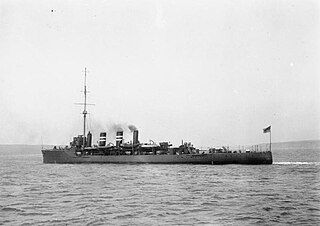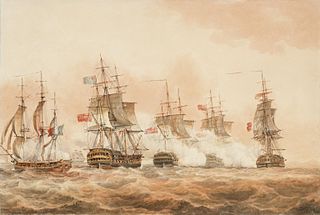Psyche is the Greek term for "soul" (ψυχή).

The Amphion class of British diesel-electric submarines were designed for use in the Pacific War. Only two were completed before the end of hostilities, but following modernisation in the 1950s, they continued to serve in the Royal Navy into the 1970s.

A ship class is a group of ships of a similar design. This is distinct from a ship type, which might reflect a similarity of tonnage or intended use. For example, USS Carl Vinson is a nuclear aircraft carrier of the Nimitz class.
Seven vessels of the British Royal Navy have borne the name HMS Amphion, after the Greek hero Amphion.

The Leander class was a class of eight light cruisers built for the Royal Navy in the early 1930s that saw service in World War II. They were named after mythological figures, and all ships were commissioned between 1933 and 1936. The three ships of the second group were sold to the Royal Australian Navy (RAN) before World War II and renamed after Australian cities.

The first USS Amphion was a former German passenger liner SS Köln for Norddeutscher Lloyd from 1899–1917. Köln had been interned in Boston on the outbreak of war in Europe and confiscated in April 1917 when the United States entered the war. The ship was under the control of the United States Shipping Board (USSB) that allocated commercial type ships to military or civilian use during the war. Köln was renamed Amphion and operated by USSB for the Army as United States Army Chartered Transport (U.S.A.C.T.) Amphion as an animal transport taking mules, horses and general cargo to forces in Europe. At the end of the war the USSB allocated the ship to the Navy, which used the ship from April to September 1919 as a troop transport for returning the United States Expeditionary Force from Europe.
USS Amphion may refer to:
Aphrodite is the Greek goddess for love and beauty
A herald is an officer of arms. It also means messenger.

HMS Amphion was an Active-class scout cruiser built for the Royal Navy before the First World War. Completed in 1913, she was initially assigned to the First Fleet and became a destroyer flotilla leader in mid-1914. When the war began, her flotilla was assigned to the Harwich Force. While patrolling on the first full day of the war, Amphion and her destroyers encountered and sank a German minelayer, SMS Königin Luise, but not before she had laid many of her mines. While returning from patrolling the following morning, Amphion struck a mine on 6 August 1914 off the Thames Estuary and sank with the loss of 132 crewmen killed. She was the first ship of the Royal Navy to be sunk in the First World War. The wreck site is protected and may not be dived upon without permission from the Ministry of Defence.

The Leander class was a four-ship cruiser programme ordered by the Admiralty in 1880. The class comprised HMS Leander, HMS Phaeton, HMS Amphion, and HMS Arethusa.

USS Amphion (AR-13) was the lead ship of her class of repair ship built for the United States Navy during World War II. The second U.S. Navy vessel to be named Amphion, she was not commissioned until January 1946, five months after the end of the war. She was decommissioned in September 1971 and transferred to the Imperial Iranian Navy as IIS Chahbahan. She was purchased outright by Iran in March 1977. After the 1979 Iranian Revolution she remained in service with the Islamic Republic of Iran Navy through at least 1985. Her fate beyond that date is not reported in secondary sources.

USS Cadmus (AR-14) was a Amphion-class repair ship of the United States Navy during World War II. Cadmus launched on 5 August 1945 by the Tampa Shipbuilding Company in Tampa, Florida, and sponsored by Mrs. B. P. Ward. Cadmus was commissioned 23 April 1946.

The Battle of Lissa, also known as the Battle of Vis; French: Bataille de Lissa; Italian: Battaglia di Lissa; Serbo-Croatian: Viška bitka) was a naval action fought between a British frigate squadron and a much larger squadron of French and Italian frigates and smaller vessels on Wednesday, 13 March on 1811 during the Adriatic campaign of the Napoleonic Wars. The engagement was fought in the Adriatic Sea for possession of the strategically important Croatian island of Vis, from which the British squadron had been disrupting French shipping in the Adriatic. The French needed to control the Adriatic to supply a growing army in the Illyrian Provinces, and consequently dispatched an invasion force in March 1811 consisting of six frigates, numerous smaller craft and a battalion of Italian soldiers.

SS Königin Luise was a German steam ferry. She operated between Hamburg and the Netherlands, before being taken over by the Kaiserliche Marine on the outbreak of the First World War. She was used as an auxiliary minelayer before being sunk on 5 August 1914.

HMS Victory is a 104-gun first-rate ship of the line of the Royal Navy, ordered in 1758, laid down in 1759 and launched in 1765. She is best known for her role as Lord Nelson's flagship at the Battle of Trafalgar on 21 October 1805.
Captain is a title, an appellative for the commanding officer of a military unit; the supreme leader of a navy ship, merchant ship, aeroplane, spacecraft, or other vessel; or the commander of a port, fire or police department, election precinct, etc. In militaries, the captain is typically at the level of an officer commanding a company or battalion of infantry, a ship, or a battery of artillery, or another distinct unit. The term also may be used as an informal or honorary title for persons in similar commanding roles.

HMS Linnet was a Laforey-class destroyer that served with the Royal Navy during the First World War. Launched on 16 August 1913 as HMS Havock, the ship was renamed on 30 September under an Admiralty order to become one of the first destroyers in a class named alphabetically. This convention subsequently became the norm. On commissioning, the vessel joined the Third Destroyer Flotilla and operated as part of the Harwich Force. The destroyer was first commanded by Commander Loftus Jones who named his daughter Linnette after the ship. During the War, the destroyer took part in the Battle of Heligoland Bight in 1914, and escorted minelayers on missions to lay mines. It was during one the latter missions that the ship was nearly hit by a gun hurled from the stricken minelayer Amphion. With the cessation of hostilities, the ship was placed in reserve and sold to be broken up on 4 November 1921.
This page is based on this
Wikipedia article Text is available under the
CC BY-SA 4.0 license; additional terms may apply.
Images, videos and audio are available under their respective licenses.











